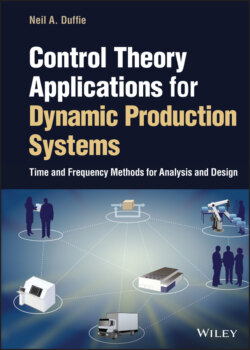Читать книгу Control Theory Applications for Dynamic Production Systems - Neil A. Duffie - Страница 26
Example 2.6 Exponential Filter for Number of Production Workers to Assign to a Product
ОглавлениеThe exponential filter shown in shown in Figure 2.10 is used in a component of a production system to make periodic decisions regarding the workforce that should be assigned to a product when there are fluctuations in demand for the product. The exponential filter has a weighting parameter 0 < α ≤ 1 that determines how significantly the amplitudes of higher-frequency fluctuations in number of workers are reduced with respect to the amplitudes of fluctuations in demand. This reduction is important because making rapid, larger amplitude changes in the number of workers is likely to be costly and logistically difficult.
Figure 2.10 Exponential filter for smoothing demand to determine the number of production workers to assign to a product.
The discrete-time equation for the filter is
where nw(kT) is the number of workers, ri(kT) orders/day is the demand, Kw workers/(orders/day) is the fraction of a worker’s day required for an order, and T days is the period between calculations of the number of workers to assign to the product.
For weighting parameter α = 0.1, Kw = 1/8 workers/(orders/day), and T = 10 days the response of number of workers is shown in Figure 2.11b for the fluctuation in demand shown in Figure 2.11a. The response was calculated recursively using the above difference equation in a manner similar to that shown in Program 2.2. The relatively small value of α results in significant smoothing of the number of workers with respect to the fluctuations in demand.
Figure 2.11 Response of desired workforce to fluctuations in demand.
